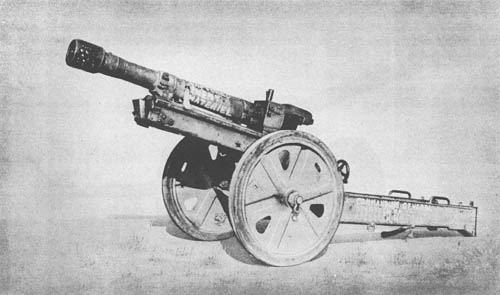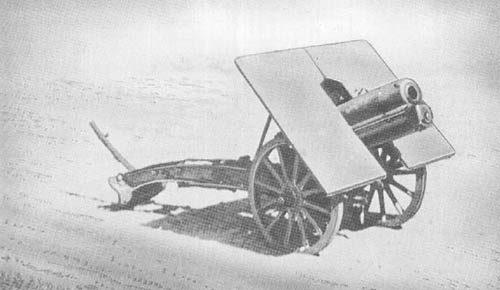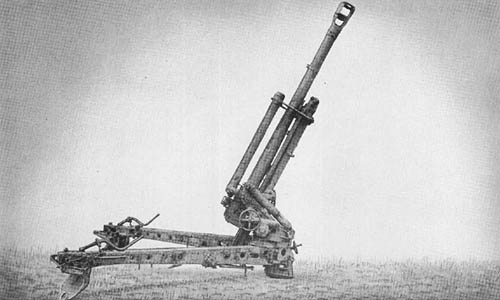
The 7.5 cm Geb. G. 36, used in the Tunisian campaign, is of comparatively recent manufacture. It can be broken down into six loads, each load having a maximum weight of 300 pounds. This enables the weapon to be used in mountainous country, as it can be easily transported by pack animal or in an airplane.
The tube is of monobloc construction, fitted with a perforated, six-baffled muzzle brake (some models of the gun are fitted with a perforated Solothurn type). The rear end of the piece is rectangular in shape, and dovetailed to fit into prepared recesses of the breech ring. A horizontal sliding type breech mechanism and continuous pull type firing mechanism are used in this gun. The recoil mechanism is hydropneumatic, but contrary to the usual design, both buffer and recuperator are positioned below the barrel.
The carriage is constructed of riveted and welded steel, with trunnion bearings to the rear. To preserve the proper balance, a spring equilibrator is located in the carriage immediately under the cradle. As is usual with most mountain guns, there is no shield. The carriage is mounted on steel disk wheels with solid rubber tires, and supported in firing position by riveted steel split trails with spade attachments.
The sight is graduated in mils from 0 to 1,250 (0° to 70° approx.) and also in meters from 0 to 1,000 (0 yds. to 1,094 yds.) for use with the hollow charge shell, 7.5 cm Gr. 38.
Both hollow-charge and high-explosive ammunition is used.
SPECIFICATIONS
| Caliber | 75 mm (2.95 ins.) | |
| Weight (complete) | 1,090 lb. (approx). | |
| Length of gun (overall) | 66 ins. | |
| Length of barrel (overall) | 56 ins. | |
| Carriage | Steel, mounted on solid disk wheels with solid rubber tires | |
| Breech mechanism | Horizontal sliding block | |
| Firing mechanism | Continuous pull | |
| Recoil mechanism | Hydropneumatic | |
| Rifling | Lands and grooves; R.H. twist | |
| Elevation | 65° | |
| Depression | 8° | |
| Traverse | 30° |
German: p. 118

